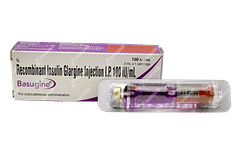Glargine
Uses of Glargine
Glargine is primarily used for managing type 1 and type 2 diabetes in adults and type 1 diabetes in children and belongs to the class of long-acting synthetic insulin analogues.
Besides controlling blood sugar levels in patients with type 1 and type 2 diabetes, it also helps manage diabetes symptoms like increased thirst, frequent urination, unexplained weight loss, fatigue, irritability, blurred vision, slow-healing sores, frequent infections, and increased ketone levels in urine.
Side effects of Glargine
Hypoglycaemia (low blood sugar)
Allergic reactions
Injection site reactions (redness, swelling, itching)
Lipodystrophy (thickening or pitting of the skin at injection sites)
Weight gain
How Glargine works
Glargine is a synthetic long-acting insulin.
It functions by acting like naturally occurring insulin in your body. Insulin is a hormone that regulates sugar levels in your blood.
It performs three key actions to manage blood sugar levels:
It stimulates the uptake of glucose in cells of skeletal muscles and adipose (fat) tissue, thus reducing the amount of glucose in your blood.
It inhibits the production of glucose in the liver, further reducing the amount of glucose available in your blood.
It reduces glucose reabsorption in the kidneys, ensuring that excess glucose is eliminated from your body through urine.
Through these actions, Glargine maintains proper glucose balance in your body and helps manage diabetes effectively.
Certified content
Written By

Doctor of Medicine
Reviewed By

BMS, FMC, MD Resident
Expert Advice
Dosage Forms Available
Glargine is available as a solution for injection.
It is administered subcutaneously under the skin.
Age and Dose Restrictions
Glargine is suitable for adults with type 1 and type 2 diabetes and in children with type 1 diabetes but not type 2 diabetes.
Contraindications
Glargine is contraindicated in patients who are allergic to insulin glargine or any of its constituents.
Other Medications to Avoid
Glargine may interact with antidiabetic agents (such as metformin and sulfonylureas), beta-blockers (like atenolol and propranolol), and thiazolidinediones (such as pioglitazone and rosiglitazone).
Before starting any prescription or over-the-counter medications, consult your doctor, as using certain medicines along with Glargine may lead to interactions.
Overdose and Missed Dose
An overdose of Glargine may result in hypoglycemia, characterized by sweating, shaking, fast heartbeat, hunger, blurred vision, dizziness or tingling hands/feet. If you observe this symptom, inform your doctor immediately.
If you forget to administer a dose of Glargine, you can take it as soon as you remember. However, if it's almost time for your next dose, then skip the missed dose and continue your regular schedule.
Management of Side Effects
Most side effects are temporary and generally harmless and resolve after discontinuing this medicine. However, if you experience any severe side effects or worsening of any of the symptoms, please consult your doctor.
For instance, drinking plenty of water may help manage dry mouth caused by Glargine.
Resting or sitting for a moment can help manage sudden dizziness or light-headedness.
Use in Driving and Operating Machinery
Glargine may cause dizziness or blurred vision. Avoid driving or operating heavy machinery if you experience these side effects.
Use in Pregnancy and Lactation
Consult your doctor before using Glargine during pregnancy and breastfeeding. It is important to manage blood sugar levels during this phase to ensure the health of both mother and baby.
Caution in Other Conditions
Patients with kidney or liver conditions should exercise caution when using Glargine.
Likewise, those with heart conditions or high blood pressure should also consult their doctor before starting on Glargine.
Special Dietary and Lifestyle Recommendations
Regularly monitor your blood sugar levels.
Maintain a balanced diet, focusing on whole grains, lean proteins, and plenty of fruits and vegetables.
Limit consumption of processed foods, sugary drinks, and high-fat snacks.
Engage in regular physical activity, such as walking, swimming or cycling.
Maintain a healthy weight. If overweight, work towards losing weight in a sustainable manner.
Avoid smoking and limit alcohol consumption.
Practice good sleep hygiene to ensure adequate rest.
Frequently asked questions
Is Glargine a type of natural insulin?
Glargine is not a type of natural insulin. It is a synthetic insulin analogue designed to mimic the body's natural insulin.
Does Glargine cause sleep disturbances?
There is no specific data indicating that Glargine directly causes sleep disturbances. However, as with any medication, individuals may have different responses and it is best to discuss any concerns with your doctor.
Can Glargine affect my fertility?
No definitive studies link Glargine with fertility issues. If you have any concerns about fertility while using this medicine, it is advisable to consult your doctor.
Are there certain foods I should avoid while using Glargine?
There are no specific food restrictions while using Glargine. However, maintaining a healthy diet helps manage diabetes better.
Is it safe to use Glargine every day?
Glargine is often administered daily to manage diabetes mellitus. The duration and dose should be as per your doctor's recommendation.
How long does it take for Glargine to start working?
After subcutaneous injection, Glargine reaches peak concentration in about 12 hours.
When is the best time to administer Glargine?
Glargine is typically administered once daily at the same time every day. The exact timing should be determined by your doctor.
Glargine in other salts
List of Medicines for Glargine







Subscribe
Registered Office Address
Grievance Officer
Download Truemeds

Contact Us
Our customer representative team is available 7 days a week from 9 am - 9 pm.
v3.7.5
Our Payment Partners








